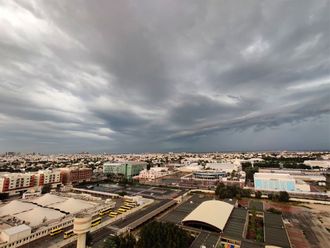
Dubai: It’s the peak of summer. The heat is searing your senses and then all of a sudden, you learn that it’s raining in Maliha, Sharjah — a mere 60-minute drive away.
On Monday afternoon, Maliha and Maskeen in Al Ain received heavy showers, accompanied by hail. So heavy was the downpour that drivers on Dubai-Al Ain Road had to park their cars by the side of the road, particularly in Al Faqa, which received the maximum rainfall recording for that day of 56.2mm.
Little wonder then that residents in Dubai and other parts of the country are smarting at what they see as nature’s bias. Why does the rain seem to have a preference for these two areas only? The answer, according to weather forecasters, has to do with the magic word called location.
“These areas where it rains in the summer are in a very good location. They’re very near to the Oman Sea and are also in proximity to the mountains,” a forecaster from the National Centre of Meteorology and Seismology (NCMS) told Gulf News.
“Location is very important for developing clouds from the easterly wind, which is coming from the Oman Sea and carrying a greater amount of water vapour,” he explained.
“During summer months, the temperature difference between land and sea is at its most [significant] — more than 15 degree Celsius.
“This temperature difference over land and sea creates a force coming off the sea to land which is called sea breeze (during the day). In the eastern and southern parts of the country, this wind is perpendicular to the series of mountains, which is very near to Al Ain and Masafi areas.”
The Hajar mountain range, which is parallel to the east coast of the UAE and extends until Oman, blocks the sea breeze from moving further inland and pushes it into the upper atmospheric layers.
“As this air climbs up, it cools down while reaching 0 degree Celsius. The [resultant] water vapour then condenses into droplets of water and falls as rain over Al Ain, Masafi and all the regions near the series of mountains.”
According to some estimates, areas near the Hajar mountains receive up to 350mm of rain annually compared to only 120mm in the interior parts of the UAE. Areas near the mountains are also significantly cooler than inland parts.
This could be the reason why a section of the media earlier this year said that the UAE is planning to construct an artificial mountain to get more rain. However, a Gulf News report in May quoting government sources denied this.
But it’s not just the mountains that make the rain, the forecaster said. The extension of the Indian monsoon from the east to Oman, parts of the UAE, Saudi Arabia and parts of Egypt also affects rainfall in the eastern and southern UAE during this period.
For residents who suggest cloud seeding in Dubai to produce more rain, forecasters said it’s impossible. Cloud seeding involves dispersing or “seeding” salt particles into clouds to attract more water vapour.
“You need clouds to seed in order to produce rain. If there are no clouds, what will you seed? In the UAE, viable clouds exist during winter until February, in some cases starting as early as November.”
During summer, in very strong instances, wind in the upper atmospheric layers blowing in from the east to the west may occasionally cause some clouds from Al Ain or Masafi areas to drift to Dubai, Ras Al Khaimah and Sharjah, said the forecaster. Although these are not rain clouds, they can still provide some respite from the harsh sun.










